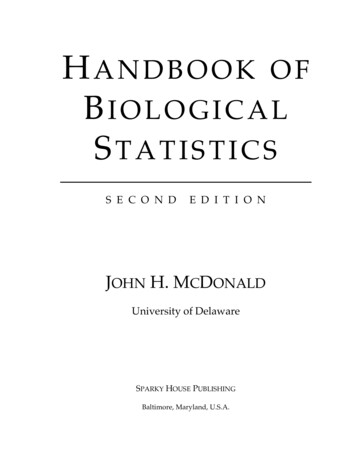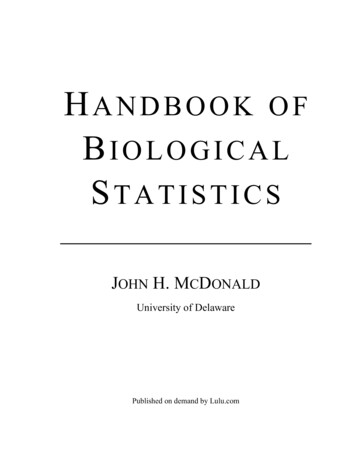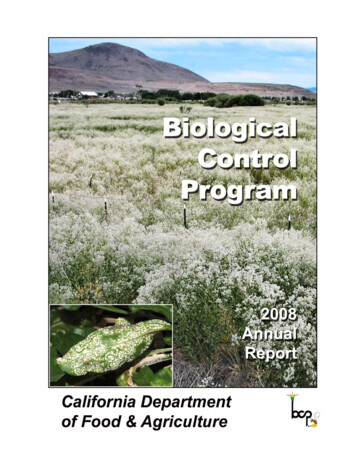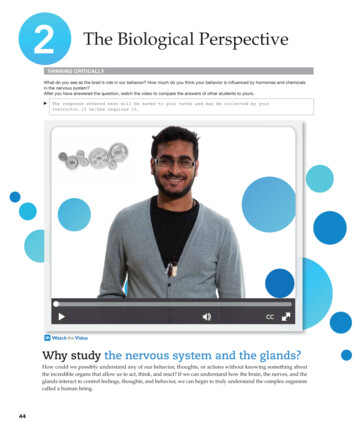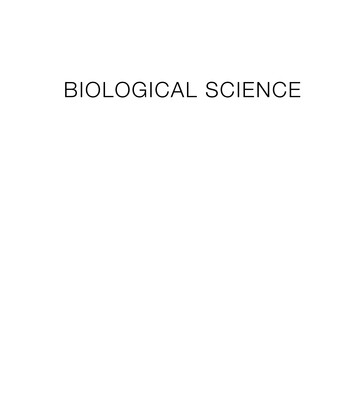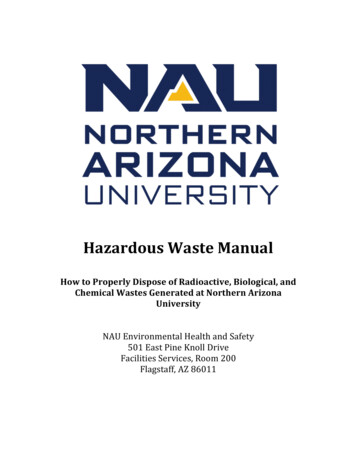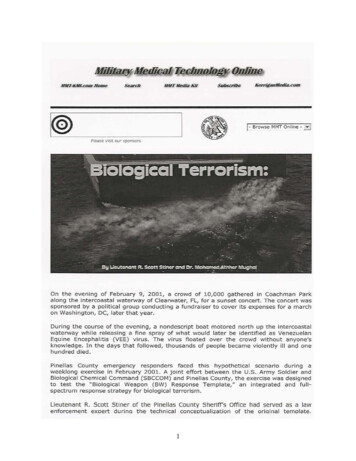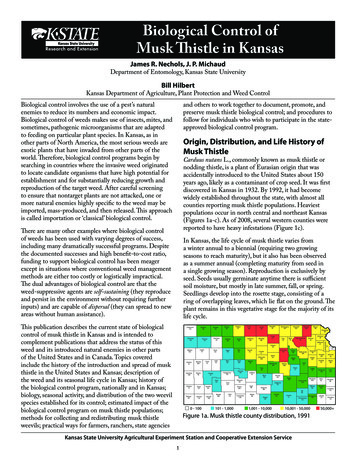
Transcription
Biological Control ofMusk Thistle in KansasJames R. Nechols, J. P. MichaudDepartment of Entomology, Kansas State UniversityBill HilbertKansas Department of Agriculture, Plant Protection and Weed ControlBiological control involves the use of a pest’s naturalenemies to reduce its numbers and economic impact.Biological control of weeds makes use of insects, mites, andsometimes, pathogenic microorganisms that are adaptedto feeding on particular plant species. In Kansas, as inother parts of North America, the most serious weeds areexotic plants that have invaded from other parts of theworld. Therefore, biological control programs begin bysearching in countries where the invasive weed originatedto locate candidate organisms that have high potential forestablishment and for substantially reducing growth andreproduction of the target weed. After careful screeningto ensure that nontarget plants are not attacked, one ormore natural enemies highly specific to the weed may beimported, mass-produced, and then released. This approachis called importation or ‘classical’ biological control.and others to work together to document, promote, andpreserve musk thistle biological control; and procedures tofollow for individuals who wish to participate in the stateapproved biological control program.Origin, Distribution, and Life History ofMusk ThistleCarduus nutans L., commonly known as musk thistle ornodding thistle, is a plant of Eurasian origin that wasaccidentally introduced to the United States about 150years ago, likely as a contaminant of crop seed. It was firstdiscovered in Kansas in 1932. By 1992, it had becomewidely established throughout the state, with almost allcounties reporting musk thistle populations. Heaviestpopulations occur in north central and northeast Kansas(Figures 1a-c). As of 2008, several western counties werereported to have heavy infestations (Figure 1c).There are many other examples where biological controlof weeds has been used with varying degrees of success,including many dramatically successful programs. Despitethe documented successes and high benefit-to-cost ratio,funding to support biological control has been meagerexcept in situations where conventional weed managementmethods are either too costly or logistically impractical.The dual advantages of biological control are that theweed-suppressive agents are self-sustaining (they reproduceand persist in the environment without requiring furtherinputs) and are capable of dispersal (they can spread to newareas without human assistance).In Kansas, the life cycle of musk thistle varies froma winter annual to a biennial (requiring two growingseasons to reach maturity), but it also has been observedas a summer annual (completing maturity from seed ina single growing season). Reproduction is exclusively byseed. Seeds usually germinate anytime there is sufficientsoil moisture, but mostly in late summer, fall, or spring.Seedlings develop into the rosette stage, consisting of aring of overlapping leaves, which lie flat on the ground. Theplant remains in this vegetative stage for the majority of itslife tonSTGrantGTMortonMTStevensSV0 - kCA101 - veyHVButlerBUSedgwickSGKingmanKMHarperHP1,001 - hautauquaCQ10,001 - 50,000Kansas State University Agricultural Experiment Station and Cooperative Extension ServiceWyandotteWYDouglasDGWoodsonWOFigure 1a. Musk thistle county distribution, 19911DoniphanDPAtchisonATLeavenworthLVThis publication describes the current state of biologicalcontrol of musk thistle in Kansas and is intended tocomplement publications that address the status of thisweed and its introduced natural enemies in other partsof the United States and in Canada. Topics coveredinclude the history of the introduction and spread of muskthistle in the United States and Kansas; description ofthe weed and its seasonal life cycle in Kansas; history ofthe biological control program, nationally and in Kansas;biology, seasonal activity, and distribution of the two weevilspecies established for its control; estimated impact of thebiological control program on musk thistle populations;methods for collecting and redistributing musk thistleweevils; practical ways for farmers, ranchers, state agenciesCrawfordCRCherokeeCK50,000
evensSVSewardSW0RushRHPawneePNClarkCA.1 - GKingmanKMHarperHP101 - 1,000CowleyCLChautauquaCQ1,001 - 10,000Trichosirocalus horridus was first released in 1978 nearManhattan by Horber. He released it again in 1982.By 1989 rosette weevils were established well enoughin isolated locations to allow for modest collecting andredistribution. In 1989, a large-scale collection and releaseprogram for both weevils was initiated by the PlantHealth Division of the Kansas State Board of Agricultureand the County Weed Directors of Kansas. The weevilredistribution program continued through f the release sites for a variety of reasons, but R. conicusdid become established in several counties in north centraland northeast Kansas. Subsequently, head weevils spreadnaturally to thistle-infested areas in adjacent counties.DoniphanDPAtchisonATCherokeeCKMore than 10,000Figure 1b. Musk thistle county distribution, MortonMTStevensSV0NessNSFordFOHaskellHSSewardSW1 - 6,642RushRHPawneePNClarkCAComancheCM6,643 - ingmanKMHarperHPSumnerSU10,964 - BElkEKCowleyCLChautauquaCQ18,271 - 30,884Counties where head weevils (Figure 2) and rosette weevils(Figure 3) were released and became established are shownbelow. The head weevil is more widely distributed thanthe rosette weevil. Part of the difference in distributionmay be that the head weevil was released almost a decadeearlier than the rosette weevil. It is also more likely thathead weevils are better adapted to a wider range of theenvironmental conditions encountered in Kansas thanare rosette weevils. Currently, head weevils are establishedthroughout most of the state. The rosette weevil isrestricted to northeast Kansas. Its range has expanded verylittle over the past 15 l Distribution in K30,885 - 64,325Figure 1c. Musk thistle county distribution, 2008The bolting stage begins with the formation of anelongated primary seed stalk and continues until flowerheads form and seeds develop. Flowers are usually reddishpink to violet or purple and the plant’s branching natureoften results in many flowers per plant. Following maturity,the head assumes a fluffy, white appearance as mature seedbegins emerging from the head. Seeds are attached to aparachute-like white pappus that facilitates dispersal onthe wind. Most seeds fall within 300 feet of the cal Control gwickSGKingmanKMBarberBAHarperHP1993 EDKiowaKWEstablishedTwo insects that help control musk thistle in Kansas areRhinocyllus conicus (Froelich), commonly called the headweevil, and Trichosirocalus horridus (Panzer), commonlycalled the rosette weevil. Both of these weevils are nativeto Europe and were studied extensively before beingreleased to control musk thistle in the United 000(53)CherokeeCK2008 (61)Figure 2. Head weevil county distribution, 1993 – BrownBRJeffersonJFOttawaOTWallaceWAIn 1973, Dr. Ernst Horber, an entomologist at KansasState University, released Rhinocyllus conicus in RileyCounty near Manhattan. From 1975-78 he madeadditional releases of head weevils in a total of sevencounties. In 1979, employees of the Kansas State Boardof Agriculture, in cooperation with the County WeedDirectors Association of Kansas, Horber, Kansas StateUniversity, and the KSU Cooperative Extension Servicereleased the head weevil in approximately 50 countiesthroughout Kansas. Establishment did not occur at HP1993 (3)Released but establishment neCNCrawfordCRCherokeeCK2008 (25)19932000Figure 3. Rosette weevil county distribution, 1993 – 20082
litter, wooded areas, and the base of plants. They remainthere until the following spring, usually producing onegeneration per year.Biology and Life HistoryHead weevilsoverwinter asadults (Figure 4)emerging in thespring to congregateon musk thistle plantsduring the boltingstage. Adults feedand mate, then layeggs on the bracts offlower buds, singlyor in clusters. Eggsare covered withFigure 4. Adult head weevil,a secretion thatRhinocyllus conicusbecomes brown ortan and appears wartyor scale-like (Figure5). Each female willlay between 100 to150 eggs. Althoughmost egg-layingoccurs on terminalbuds, eggs may belaid on the stemsFigure 5. Musk thistle flower head and secondary budsshowing head weevil egg masses when infestations areheavy. Cool weathercan extend the egglaying period, whileextremely hot weatherwill decrease it.Rosette weevilRosette weevil adultstypically appear betweenMay and June as theyemerge from pupal casesin the soil. Rosette weeviladults are reddish-brown,changing to dark brownor black, with a somewhatmottled appearance thathelps distinguish themfrom head weevils (Figure7). They are more robust Figure 7. Adult rosette weevil,and less elongate thanTrichosirocalus horridushead weevils, with bodiesslightly longer than wide. They also have a moderatelylong and slender beak. After light feeding on the hostplant, newly emerged adults seek sheltered habitat, such asground litter, where they spend the hot summer months.During this dormant period, the weevils do not reproduceor feed.As temperatures dropin the fall, adult femalesemerge from summerresting places, mate,and begin to lay eggsin leaf midribs on theundersides of leaves ofthistle rosettes. Onefemale may lay as manyas 800 eggs. Eggs laid inearly fall will hatch bylate fall; however, eggslaid in late fall and early Figure 8. Split crown showingrosette weevil larvaewinter may not hatchuntil the following spring. Consequently, the rosette weevilmay overwinter as egg, larva, or adult. Overwintered adultscontinue to lay eggs through early spring, with the majorityof eggs laid during that time. Upon hatching, larvae beginfeeding within the midrib and soon migrate toward thecenter of the thistle rosette (Figure 8). Continued feedingby larvae causes a blackened area of dead crown tissue,commonly referred to as ‘deadheart’ (Figure 9). As theyreach maturity, larvae leave the plant and pupate in thesoil. Pupation requires 12 to 20 days depending on thetemperature.Eggs hatch in sixto nine days, andlarvae immediatelyburrow into thebase of the flowerFigure 6. Mature flower headshowing head weevil larvae inside and begin feedingon the ovaries andsurrounding tissue, reducing the reproductive potential ofthe thistle. Larvae are small, creamy-white, legless grubs.They remain in the flower, feeding for 25 to 35 days untilfully developed (Figure 6). They pupate within a special cellcarved out in the flower head over a period of eight to 14days. Many larvae congregate in one head; the more larvaeper head, the fewer seeds that are produced.Adults may remain in the cells for up to two weeks,changing color from cream to almost black. Newlyemerged adults are about a quarter-inch long. They aregenerally black, mottled with numerous yellowish-whiteblotches. Their bodies are noticeably elongate, and theypossess a short, blunt snout with antennae attached. InKansas, adults may emerge from mid-July through midAugust. They seek shelter to overwinter, such as groundWeevil ImpactHead weevils are consistently abundant at most thistleinfested sites in eastern Kansas and in many other partsof the state. They infest a high percentage of flower heads3
weevil populationswere low, thistlesgrew to normalheight and flowerhead production wasnot reduced. Thissuggests that thereare many years ineastern Kansas whenrosette weevils maynot contribute muchto the biologicalFigure 10. Multi-stemmed muskcontrol of muskthistle plant caused by budthistle. But in thedestruction from rosette weevilsthird year of thestudy when natural populations of rosette weevils werehigher (about 65 to 70 larvae per plant), musk thistlegrowth was altered. Multiple flower stems were producedin response to the destruction of initial buds and thesewere shorter than the primary stems of uninfested plants(Figure 10). More importantly, plants heavily infested withrosette weevils produced fewer flower heads, which meansless viable seed. In rare years when rosette weevil densitiesexceed 70 larvae per plant, rosettes may be destroyed, butthis is uncommon.beginning in latespring as soonas floral buds areavailable. Egg-layingcontinues until aboutmid-June when theystop producing eggs.But musk thistleplants may continueto produce flowerFigure 9. Dead tissue at center ofheads for a variablerosette is called ‘deadheart’period, dependingon seasonal rainfall and temperature. During cooler,rainier summers, new thistle heads may be produced for anextended period after weevils have stopped laying eggs.In contrast to the head weevil, rosette weevil populationsare generally much lower. Based on observations made overmany years by KDA personnel, rosette weevil numbersfluctuate but are found at low levels in about 8 of every10 years. One hypothesis for the generally low rosetteweevil populations is that they suffer high winter mortality.Periods of extreme cold weather associated with little orno insulating snow cover are common throughout Kansas.Rosette weevil populations may be higher, for example, inOklahoma, which has milder winters than Kansas.In Oklahoma, in some fields where rosette weevils areestablished, there have been reports of thistle death inthe rosette stage or damage at such high levels that noflowering occurred. Whether these impacts are related torosette weevils at population levels higher than have beenfound in Kansas is unclear because weevil counts were notrecorded. It is also possible that some or all of the addedimpact on musk thistles was caused by heat or droughtstress, but this, too, is inconclusive.Experimental EvidenceHistorically, the biological control program for musk thistlein Kansas has been considered a success based on evidenceof establishment and high infestation levels, mainly of headweevil. This assumption has been supported by accountsfrom farmers, ranchers, and state and county personnel ofextensive, dense stands of musk thistle before the release ofweevils and subsequent observations of reduced densitiesand coverage. But other factors such as more extensive useof better herbicides and improved land management mayhave also contributed. Data are lacking that would directlylink weevil presence and abundance with reductions inmusk thistle populations, which occur over a number ofyears. The first field experiments that directly measured theimpact of the two weevils were conducted in the late 1990sand early 2000s at K-State by Lindsey Milbrath under thedirection of Dr. Jim Nechols. Over a three-year period,Milbrath evaluated the role of each weevil separately aswell as their combined impact. The goal was to determinewhether redistribution of the less-widespread rosette weevilto areas infested only with head weevils could improvebiological control.When both weevils occurred together at high densities innortheast Kansas, their combined impact was greater thanwhen only head weevils were present (59 percent versus45 percent seed reduction). These results suggest thatthe two weevils may provide enhanced biological controlvia their additive impacts, although this may happenonly occasionally in Kansas. The average impact on seedproduction from one or both weevils was about 50 percentbased on three field seasons. Assuming these resultsprovide a good estimate of average long-term impact, atleast half of the viable seed — around several thousandseeds for a vigorous plant — will be deposited in the seedbank, remaining dormant in the soil for a number ofyears. So an important question is whether there is enoughviable seed at any given time to cause future musk thistleoutbreaks if conditions become favorable — for examplewhen established vegetation is disturbed or overgrazed.This field study provided some important insights intoweevil impacts on musk thistle in Kansas. First, headweevils reduced viable seed production by about 45 percenton average, despite the fact that thistles continued toproduce flower heads beyond the head weevil egg-layingperiod in all three years. Second, in two years when rosetteApart from the direct impact that weevils have on seedset, an equally important biological control benefit may4
be to reduce musk thistle’s competitive ability with othervegetation. For example, by creating shorter plants withmore branches, rosette weevils may enable grasses andother vegetation to outcompete established thistle plants.In addition, shorter thistles may disperse seed over shorterdistances, which may reduce the spread of seed to newlydisturbed areas.of uninfested plants are also signs. This occurs when theapical bud has died and secondary buds develop, butbecause there are other possible causes for this, furtherexamination is needed. Digging into the crown of the plantand splitting it open may expose larval tunnels and possiblyrosette weevil larvae, depending on the time of the year(Figure 8).The individual and combined impact of head and rosetteweevils on musk thistle is difficult to predict becauseexisting experimental data apply only to a limited area ofnortheastern Kansas. It is likely that weevil populationsand thistle vigor and productivity will vary throughoutthe state, and these differences will result in differentlevels of biological control. On a broader geographic scale,differences in weevil impact in different states can beexpected. For example, in Oklahoma the impact of muskthistle weevils — in particular, the rosette weevil — maybe greater than in Kansas because of climatic differencesaffecting weevil and musk thistle populations. This suggestsadditional observations and experiments are needed.Estimating Distribution and AbundanceTo evaluate the extent of infestation and relativeabundance of head and rosette weevils, infestations ofmusk thistle should be mapped at different sites withinthe county and then examined for signs and symptomsof weevils. It is also helpful to estimate the approximatenumber of plants or the area covered by the thistleinfestation because weevils depend on weed abundance —the more thistles, the greater the chance of weevil presence.At each site, a number of plants should be examined —enough to compute a reasonable percentage infestationfor each weevil or to be satisfied that it is absent. If thearea involved is small, all plants can be examined, but ifthe area is large with musk thistle scattered throughout,sampling should be done to cover the most ground withthe least effort necessary to permit a good assessment.This is usually accomplished by walking along one or morestraight lines (transects) across the entire field, examiningthistle plants along the way. If the stand is sparse, all plantswithin an arm’s reach of the transect may be sampled. Ifthe field is large, divide it into evenly spaced zones with atleast two transects across it. If there are many thistle plantsspread over a large area, a fixed proportion of plants can besampled along each transect (e.g., every other plant, everyfifth plant, etc.).Surveys for Weevil PresencePrograms to redistribute musk thistle weevils are costlyand should not be considered without first determiningwhether weevils are present. Where they do occur,information on weevil abundance is useful because ithelps to identify target areas for possible redistributionand impact assessment and may contribute to a betterunderstanding of geographic differences in weevildistribution and impact. Current distribution maps,although helpful, almost certainly underestimate the zoneof establishment of both weevils in Kansas and provideno information on relative abundance or the area infested.The most efficient way to obtain information aboutweevil activity is a grassroots approach involving farmers,ranchers, and government workers who live and work incounties where assessment is needed. Contributors shouldknow how to recognize each weevil and how and when toexamine plants.The objective is to sample a reasonable number of plants(20 or more, depending on the area covered) to get arepresentative sample of weevil presence. It is also usefulto estimate the relative abundance of each weevil. For headweevils, abundance can be estimated as the percentageof infested flowers (the percentage of heads with one ormore weevils in any life stage). In addition, a count of thenumber of egg masses per flower will give the egg massconcentration — or how heavily infested different flowerheads are. For rosette weevils, dig the plant out at thecrown, split it open, and then count the number of larvaeinside. The best time to do this is in mid to late springwhen larvae are still developing, but before they haveexited the plant to pupate in the soil.DetectionTo detect head weevils, it is best to look on the bractsof flowers for the tannish egg masses that persist on theflower heads for many weeks (Figure 5). Flower heads canbe split and examined for cream-colored larvae (grubs)to reveal the stage of population development, but isnot necessary for diagnosing infestation. Adults of therosette weevil can be found by examining the undersidesof the leaves on flattened rosettes before bolting. Newlyemerged adults may also be found on bolted, floweringplants in May and June. Indirect indications of rosetteweevil presence are the presence of rosettes withblackened centers where larvae have bored and killedthe terminal bud (Figure 9). Plants with multiple stemsthat are somewhat shorter than the single primary stemImplementing a Biological Control ProgramIn 1987, the Kansas State Board of Agriculture (now theKansas Department of Agriculture) established guidelinesfor farmers and ranchers who were interested in usingweevils for musk thistle biological control. Both weevilspecies were once available for mail order purchase, but5
changes in federal regulations now prohibit their transportacross state lines, although not their redistributionwithin states. In 2006, KDA outlined “an official muskthistle control program” in section 4-8-27 of KansasAdministrative Regulations. Landholders wishing torelease or redistribute weevils in Kansas must now generatea biological control plan in consultation with their countyweed control director. The plan must meet specific criteriaoutlined in section 4-8-41 and be approved by KDA. Onlythen will the applicant receive a specific exemption fromrequirements to implement other control measures withinthe area covered by the biological control plan. The planmust provide for the maintenance of a continuous thistlefree border at least 150 feet wide around the perimeter ofthe release area by conventional means (approved culturalor chemical controls). The required width of the borderwill be determined by the county weed director who willconsider factors such as the prevailing wind directionduring June and July, the presence of shelter belts andtree lines, the slope of the terrain, the density of the muskthistle population, and the number of weevils that shouldbe released.release. Adults are easier to gather after the thistle plantsbegin bolting and mated females capable of laying eggsimmediately after release are abundant at this time.Research suggests that establishment is 25 times morelikely with spring-released weevils than with those releasedin late summer. But if weather or other factors preventspring collection, this may be done mid to late summerbefore adults emerge from the seed head. Newly emergedrosette weevil adults do not appear until late spring orearly summer, and rarely before bloom, but they remainon plants for some time before entering summer restingplaces. Rosette weevils are usually abundant on plantsduring seed development, but as weather becomes hotterin mid-summer, they disperse to seek shelter from theheat and to avoid desiccation, remaining dormant untilfall when thistles have germinated and new rosettesare available. Collection in fall is more difficult than inspring because plants are in the small rosette stage. Figure11 shows theequipment neededto collect anddistribute weevils:(A) large plasticor aluminum pan(wash, pie or cake),(B) aspirator, (C)insect sweep net,(D) one pair ofFigure 11. Equipment commonlyleather gloves, (E) used to collect head and rosette1-pint cardboardweevilscarton (e.g., icecream), (F) insulated ice chest, (G) freezer packs or ice, (H)plastic bag, a large bucket, and a 3-foot long beating stick(not shown).Herbicide treatments within the release area are permitted,as needed, only between the dates of October 1 and April15. Hay cannot be removed from the biological controlarea unless it has been deemed to be musk thistle-freeby the county weed director within the seven days beforeharvest. Failure to comply with these criteria may resultin the biological control plan being revoked, obliging theparticipant to revert to conventional control measures inorder to remain in compliance with noxious weed controlobligations.Choosing a Release SiteThere are a number of factors to consider in choosing agood site for releasing musk thistle weevils. Plant densityis critical; a minimum of 1,000 plants per site is preferred.Available moisture is a factor that may improve shortterm survival, especially for rosette weevils, thus increasingchances of permanent establishment. Sites near a pond orcreek are most desirable. Areas with minimal disturbancealso favor weevil establishment and population increase.Thistle plants should not be mowed, cut or sprayed for atleast two years following any release, and an even longerperiod is preferred. Cattle should not be allowed to grazein the area, especially during egg-laying periods. Areas thatminimize chances for seed dispersal should be consideredwhenever possible. A creek bottom, deep brushy draw orbluff that will prevent the long distance spread of viableseeds is ideal. Such sites also provide some protection fr
In 1973, Dr. Ernst Horber, an entomologist at Kansas State University, released . Rhinocyllus conicus in Riley County near Manhattan. From 1975-78 he made additional releases of head weevils in a total of seven counties. In 1979, employees of the Kansas State Board




